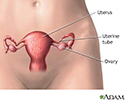Mittelschmerz
Ovulation pain; Midcycle pain
Mittelschmerz is one-sided, lower abdominal pain that affects some women. It occurs at or around the time when an egg is released from the ovaries (ovulation).
Causes
One in five women have pain around the time of ovulation. This is called mittelschmerz. The pain may occur just before, during, or after ovulation.
This pain can be explained in several ways. Just before the ovulation, the growth of the follicle where the egg develops may stretch the surface of the ovary. This can cause pain. At the time of ovulation, fluid or blood is released from the ruptured egg follicle. This may irritate the lining of the abdomen.
Symptoms
Mittelschmerz may be felt on one side of the body during one month and then switch to the other side during the next month. It may also occur on the same side for many months in a row.
Symptoms include lower-abdominal pain that:
- Occurs only on one side.
- Goes on for minutes to a few hours. It can last up to 24 to 48 hours.
- Feels like a sharp, cramping pain unlike other pain.
- Is severe (rare).
- May switch sides from month to month.
- Begins midway through the menstrual cycle.
Exams and Tests
A pelvic exam shows no problems. Other tests (such as an abdominal ultrasound or transvaginal pelvic ultrasound) may be done to look for other causes of ovarian or pelvic pain. These tests may be done if the pain is ongoing. In some cases, the ultrasound may show a collapsed ovarian follicle. This finding helps support for the diagnosis.
Treatment
Most of the time, treatment is not needed. Pain relievers may be needed if the pain is intense or lasts a long time. In patients with Mittelschmerz-related symptoms that interfere with their normal activities, the use of an oral contraceptive may be used to control symptoms.
Outlook (Prognosis)
Mittelschmerz can be painful, but it is not harmful. It is not a sign of disease. It may help women to be aware of the time in the menstrual cycle when the egg is released. It is important for you to discuss any pain you are having with your health care provider. There are other conditions that can cause similar pain that are much more serious and require treatment.
Possible Complications
Most of the time, there are no complications.
When to Contact a Medical Professional
Contact your provider if:
- Ovulation pain seems to change.
- Pain lasts longer than usual.
- Pain occurs with vaginal bleeding.
Prevention
Birth control pills can be taken to prevent ovulation. This can help reduce pain that is linked to ovulation.
References
Chen JH. Acute and chronic pelvic pain. In: Mularz A, Dalati S, Pedigo R, eds. Ob/Gyn Secrets. 4th ed. Philadelphia, PA: Elsevier; 2017:chap 16.
Harken AH. Priorities in evaluation of the acute abdomen. In: Harken AH, Moore EE, eds. Abernathy's Surgical Secrets. 7th ed. Philadelphia, PA: Elsevier; 2018:chap 12.
Moore KL, Persaud TVN, Torchia MG. First week of human development. In: Moore KL, Persaud TVN, Torchia MG, eds. The Developing Human. 11th ed. Philadelphia, PA: Elsevier; 2020:chap 2.
Yazdani A. Pelvic pain. In: Cameron P, Little M, Mitra B, Deasy C, eds. Textbook of Adult Emergency Medicine. 5th ed. Philadelphia, PA: Elsevier; 2020:chap 19.1.
Review Date: 4/1/2023



